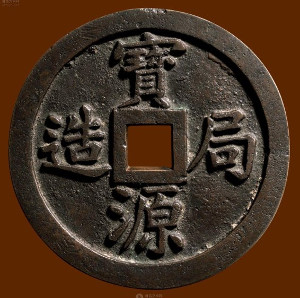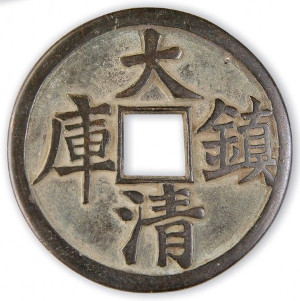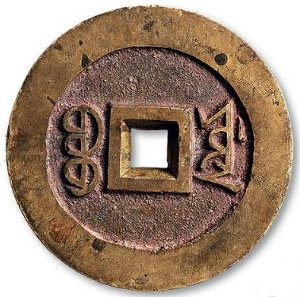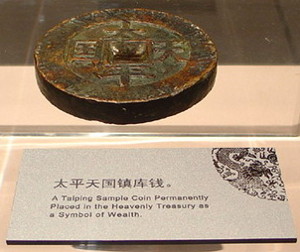On special occasions in ancient times, Chinese mints would cast an unusually large, thick, heavy and well-made coin.
The coin was known as a “vault protector” (zhen ku qian 镇库钱).
The coin was not for circulation but occupied a special place at the treasury.
The treasury had a spirit hall where offerings could be made to various gods including the God of Wealth (财神). The special coin would sometimes be hung with red silk and tassels above the incense table in the spirit hall.
The vault protector coin was believed to have charm-like powers that provided protection from disaster and evil while ensuring good fortune and wealth.

Vault protector coin “da tang zhen ku” of Southern Tang
Shown at the left is the earliest vault protector coin know to exist, and also the most famous.
The inscription da tang zhen ku (大唐镇库) translates as “Vault Protector of the Tang Dynasty”.
The translation is a little misleading, however, because the coin was not produced during the great Tang Dynasty (618-907).
The coin is actually attributed to the short-lived Southern Tang (nan tang 南唐 937-976) which was one of the Ten Kingdoms that existed after the fall of the Tang.
The coin was cast during the baoda period (保大 943-957) of the reign of Yuanzong (元宗), also known as Li Jing (李景 or 李璟), of the Southern Tang.
Yuan Zong cast large quantities of coins including kai yuan tong bao (开元通宝), tang guo tong bao (唐国通宝), bao da yuan bao (保大元宝) and da tang tong bao (大唐通宝).
In addition to the da tang tong bao (大唐通宝) coins, he also had cast this large vault protector coin with the inscription da tang zhen ku (大唐镇库).
The coin retains the characteristics of Southern Tang coins.
The diameter is 6 cm, the thickness is 0.6 cm, the diameter of the hole is 1.24 cm and the coin weighs 93.7 grams.
The coin was originally acquired in the early 20th century by Mr. Fang Yaoyu (方药雨), a well-known coin collector in Tianjin. The coin was later owned by Mr. Chen Rentao (陈仁涛).
Since the early 1950’s, this famous da tang zhen ku vault protector coin has been in the collection of the National Museum of China (中国国家博物馆).
It is the only authentic specimen known to exist.

Qing Dynasty vault protector on display at the Leizhou City Museum
At the left is a vault protector coin dating from the Qing dynasty on display at the Leizhou City Museum (雷州市博物馆).
Leizhou City (雷州市) is located in Guangdong province (广东省).
The obverse side (not shown) of the coin has the inscription xian feng tong bao (咸丰通宝) which means the coin was cast during the reign of the Xianfeng Emperor (咸丰帝), 1850-1861.
The inscription on the reverse side, seen above, is da qing zhen ku (大清镇库) which means “Vault Protector of the Qing Dynasty”.
According to this article, there were a total of five of these special vault protector coins cast. In the early years of the Republic (1912-1949), a eunuch stole the coins. Three of the coins were sold to an Englishman for “a large amount of money”. One of the remaining coins is at the Leizhou City Museum and the other is at The Palace Museum (故宫博物院) in Beijing.
The coin has a diameter of 14 cm. The square hole is 2.5 cm. The coin weighs 1050 grams.

Vault protector coin cast at the Board of Works during the reign of the Xianfeng Emperor of the Qing Dynasty
Shown at the left is another vault protector coin from the Qing Dynasty.
The inscription reads bao yuan ju zao (宝源局造) which means “made by the Board of Works”.
The reverse side has the Chinese inscription zhen ku (镇库) which means “vault protector”.
According to Mr. Ma Dingxiang (马定祥), one of the most famous Chinese numismatists of the 20th century, this vault protector is consistent with the style of coins cast during the reign of the Xianfeng Emperor.

Reverse side of vault protector coin cast during the reign of the Xianfeng Emperor
This very large coin has a diameter of 11.52 cm and weighs 837.3 grams. The center hole is 1.8 cm.
According to “Coins in China’s History” published in 1936 by Arthur B. Coole (邱文明), only 4 or 5 of these vault protector coins from the Board of Works (宝源局) exist. Mr. Ma Dingxiang states in his book on the coins of Xianfeng (咸丰泉汇), that there exists just one specimen of a companion vault protector coin that was cast at the same time at the Board of Revenue (宝泉局).
This coin sold at auction in 2013 for $408,279 (RMB 2,530,000) which, at the time, broke the record for the most ever paid for a Qing dynasty coin.
In 1861 during the last days of his life, the Xianfeng emperor made arrangements for his son, Zaiqun, to succeed him as emperor.

Rare Qixiang vault protector coin
The new emperor was to take the reign title of Qixiang (祺祥).
With the passing of Xianfeng, however, a coup took place resulting in a change of the reign title. The new reign title was to be Tongzhi (同治).
For a period of about one month, however, the mints produced coins with the inscription Qixiang. Authentic Qixiang coins are scarce because they were only cast for a very short period of time.
Displayed above is a rare Qixiang vault protector coin.
The inscription reads qi xiang zhong bao (祺祥重宝).

Reverse side of Qixiang vault protector
The inscription on the reverse side is da qing zhen ku (大请镇库) which translates as “Vault Protector of the Qing Dynasty”.
This coin is 10.1 cm in diameter and has a thickness of 0.47 cm.
The coin does not indicate the mint that produced it.
This very large and rare Qixiang vault protector coin sold at auction in 2013 for $745,755 (HK$5,750,000).

Qing dynasty “guangxu tong bao” vault protector coin
Another vault protector coin from the Qing dynasty is shown at the left.
The inscription reads guang xu tong bao (光绪通宝).
The coin was cast as a vault protector during the reign of the Guangxu Emperor (光绪帝) 1875-1908.
The coin is very well cast and the bronze is exquisite.

Reverse side of Qing dynasty vault protector coin
The reverse side, shown at the left, has the inscription bao yuan (宝源) meaning it was cast at the Board of Works in Beijing.
The diameter is 6.2 cm.
The thickness is a remarkable 1 cm.
This coin sold at auction in 2010 for $51,485 (RMB 319,200).

Taiping Rebellion “Taiping Tian Guo” vault protector coin
According to Mr. Ma Dingxiang (马定祥), this is a vault protector coin cast during the Taiping Rebellion (1850-1864).
The inscription on the obverse reads tai ping tian guo (太平天国) which translates as the “Heavenly Kingdom of Great Peace”.
The coin has a diameter of 7.6 cm.

Reverse side of Taiping Rebellion vault protector coin
The reverse side of the coin has the inscription sheng bao (圣宝) which translates as “Sacred Currency”.
Mr. Ma discusses the coin in his book “Coins of the Taiping Heavenly Kingdom” (太平天国钱币).
These large, well-crafted vault protector coins were produced during the later period of the Taiping Rebellion in Hunan, Suzhou and Hangzhou.
This specimen was in the collection of Mr. Ma and sold at auction in 2011 for $111,286 (RMB 690,000).
There are only five or six of these coins known to exist and they all display very slight differences.

Taiping Heavenly Kingdom vault protector coin at Taiping Heavenly Kingdom History Museum
Another specimen of a Taiping Heavenly Kingdom vault protector coin (太平天国镇库钱) is shown at the left.
The coin is in the collection of the Taiping Heavenly Kingdom History Museum (太平天国厉史博物馆) in Nanjing.
The description in the exhibit reads “A Taiping Sample Coin Permanently Placed in the Heavenly Treasury as a Symbol of Wealth”.
It can be clearly seen in this image just how thick these vault protector coins really are.
There is some speculation that a very large and heavy banliang coin (半两) made of silver was cast by the State of Qin (秦) in 336 BC to serve as a vault protector. Please see “State of Qin Silver Banliang Coin” for a detailed discussion.
Because vault protector coins are so rare, there is no shortage of fakes appearing on the market. In doing research for this article, I found several coins described as vault protectors which I found questionable. Collectors of these special coins therefore need to be especially careful.
China nowadays issues on a regular basis a large variety of special commemorative coins made of precious metals such as gold or silver. These coins are not meant for circulation. They are popular as collectables and investments.
Some of these modern coins are modeled after the vault protector coins of ancient times.
In 1998, a gold coin modeled after the “Vault Protector of the Tang Dynasty” discussed above was issued. A gold version of the Emperor Xianfeng vault protector discussed above was minted in 1990. Finally, a gold coin based on a different Emperor Xianfeng vault protector was produced in 1982.
Hello , recently purchased a Mixiqian Chinese sex education Marriage charm
from an estate sale. I do not see one pictured above. it is a very large heavy coin 64 m m diameter inscription reads “wind, flowers, snow, moon” reverse side depicts 4 couples making love. charm may be from Qing Dynasty 1644-1911 AD. would like to get it appraised. Very Greatful for any help that could send me in the right direction. Thankyou
Hi Ezra,
I will email you requesting additional information.
Thanks,
Gary
Dear Gary,
I would like to ask you about some coins found in an archaeological excavation in Cambodia but have been unable to get your email address from the Primal Trek website. Could you contact me please?
I just received what appears to be a vault protector charm based on your article. It was a gift of a Korean family whose son is one of my employees. They purchased it in an antique shop near or in Seoul. Based on the inscription, it dates to the first Ming Emperor circa 1368 – if its authentic. Measures 9.24 cm in diameter and weighs 285 grams. Hoping to send you some photos and learn more about it. Regards. Pete
Dear sir,
I have read your interesting article on Chinese Vault Protector Coins. I am interested to know more details of the auctions in Hong Kong and Japan where these pieces were sold. If you could provide me with the names of the auction houses and the precise sale dates I would be most grateful.
Kind regards
Andre de Clermont
I commented in November last about the Chinese Vault Protector coins. I am in possession of an example which seems to match the Xianfeng specimen in the Leizhou City Museum which you refer to in your article. The diameter and weight of my example exactly match the figures mentioned in your article. The provenance of my piece is from the collection of a British colonial administrator who spent his working life in Hong Kong and China between the mid-1880s and 1920s. I am seeking confirmation of the authenticity of my piece, and if you can help in any way, I would be grateful. I would also like to send you pictures, so an email address or further contact details would be very much appreciated.
I will contact you via email.
Thanks,
Gary